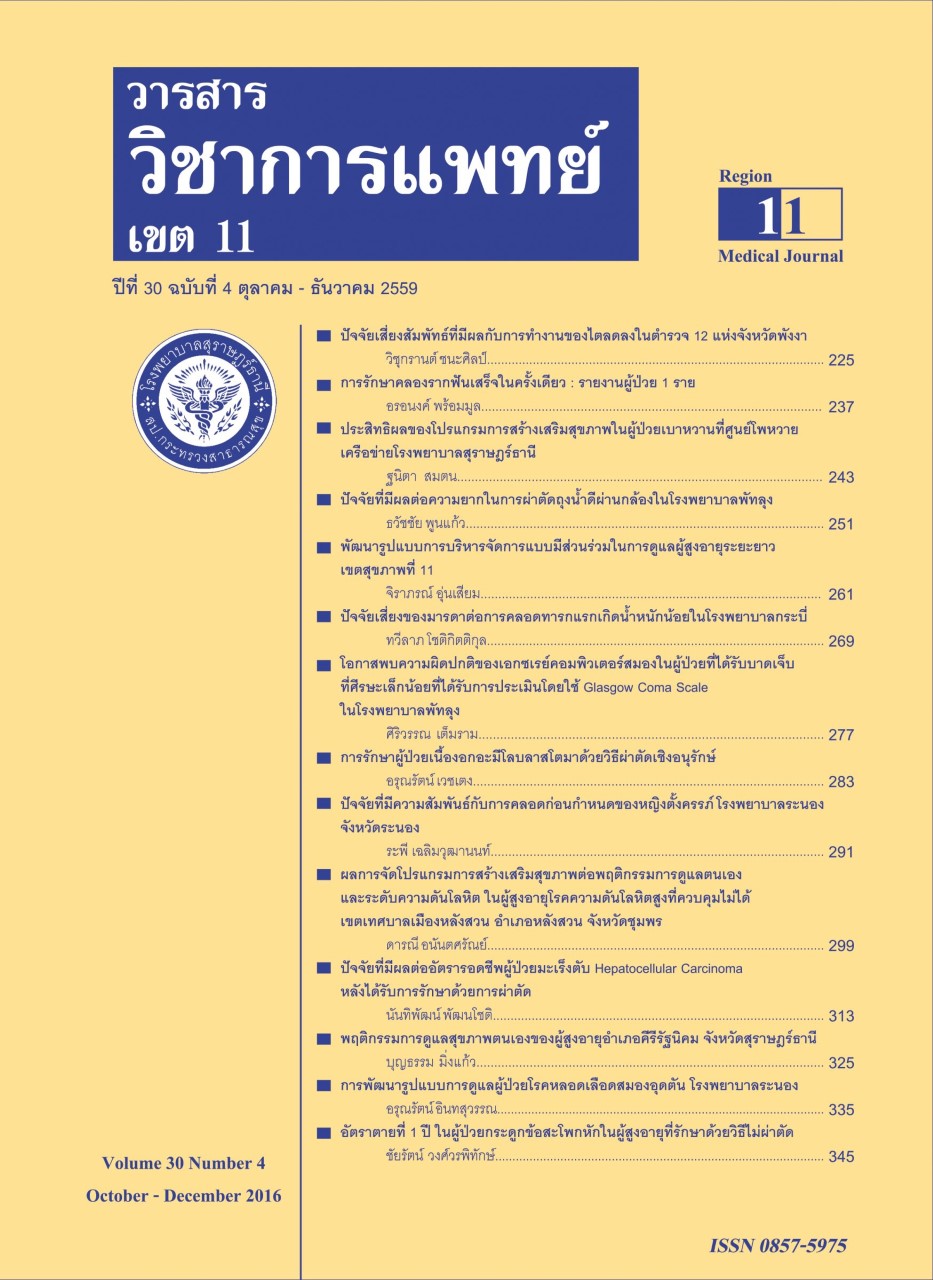Maternal Risk Factors of Low Birth Weight Infant at Krabi Hospital
Keywords:
LBW infant, risk factorAbstract
Low birth weight (LBW) infant is an important indicator of obstetrical services. Mortality, morbidity and developmental impairment are increased in these infants more than normal weight infants. To find out maternal risk factors of LBW infant born in Krabi Hospital, a retrospective case control study was performed. 1,628 mothers who delivered during October 1, 2014 to September 30, 2015 at Krabi Hospital were included in the study. 120 mothers who
delivered infants of weight <2,500 gm were the study group and the rest 1,508 mothers who delivered infant weight ≥2,500 gm were the control group. Characters of population were described with number and percent. Data were analyzed by chi-square test and multiple logistic analysis, using odds ratio (OR) and 95% confidence interval (95% CI) at level of significant p≤0.05. Univariate analysis revealed that maternal gestational age<37weeks(OR = 10.05),
maternal weight gain <10 kg (OR = 4.08), body mass index <20 kg/m2 (OR = 2.20) and antenatal care (ANC) visit <4 times (OR = 3.48) were significant risk factors. After multiple logistic regression analysis was achieved, the only two risk factors were significant reliable. The highest was maternal gestational age <37 weeks (AOR = 10.04) the other one was maternal weight gain <10 kg (AOR = 6.03). Therefore this study indicated that surveillance and prevention of preterm labor and improved maternal nutrition status to gain appropriated weight during pregnancy should be done to decrease the incidence of LBW infant.
References
2. สถานการณ์ปัญหา เอกสารประกอบการนิเทศสาธารณสุขผสมผสานระดับจังหวัด รอบที่ 2/2559 คปสอ เมืองกระบี่ จังหวัดกระบี่; 2559: 1-2.
3. สำนักส่งเสริมสุขภาพ กรมอนามัย. คู่มือการดำเนินงานโรงพยาบาลสายใยรักแห่งครอบครัว ภายใต้ชุดสิทธิประโยชน์หลักประกันสุขภาพถ้วนหน้าด้านส่งเสริมป้องกัน และเฝ้าระวังการเจ็บป่วยกลุ่มหญิงมีครรภ์และเด็กแรกเกิด – 5 ปี พ.ศ.2551. นนทบุรี: กรมอนามัย; 2550.
4. Cunningham FG, Levano KJ, Bloom SL, Spong CY, Dashe JS, Hottman BL, et al. Williams Obstetrics. 24th ed. New York: McGraw-Hill Professional; 2014: 3.
5. Anderson MS, Hay WW Jr. Intrauterine growth restriction and the small for gestational age infant. In: Avery GB, Fletcher AM, MacDonald MG,
editors. Neonatology, pathophysiology and management of the newborn. 5th ed. Philadelphia: Lippincott William & Wilkins: 1999. P.411-44.
6. นฤทธิ์ อันพร้อม. Risk factors of low birth weight infants. วารสารกรมการแพทย์ 2539; 21: 136-45.
7. เรณู ศรีสมิต, สมบูรณ์ศักดิ์ ญาณไพศาล, จินดา วังวิญญู, ศุภพร โกรัตนะ,Kilmarx PH, ครรชิต ลิมปกาญจนารัตน์. แนวโน้มและปัจจัยเสี่ยงของน้ำหนักเด็กแรกคลอดต่ำในโรงพยาบาลเชียงรายประชานุเคราะห์ พ.ศ. 2533 – เดือนมิถุนายน พ.ศ. 2540. วารสารวิชาการวิชาสาธารณสุข 2541; 7: 32-8.
8. สุรชัย พงศ์หล่อพิศิษฏ์, ปัจจัยเสี่ยงของมารดาต่อการคลอดทารกแรกเกิดน้ำหนักน้อยในโรงพยาบาลเถิน จังหวัดลำปาง. ลำปางเวชสาร 2552; 30: 146-53.
9. สมชาย หฤหรรษวาสิน. ปัจจัยเสี่ยงของมารดาต่อการเกิดทารกแรกเกิดน้ำหนักน้อยในโรงพยาบาลศูนย์เจ้าพระยายมราช สุพรรณบุรี. วารสารวิชาการสาธารณสุข 2552; 18: 362-8.
10. สันสนีย์ หาญพินิจศักดิ์. ปัจจัยเสี่ยงต่อการเกิดทารกแรกเกิดน้ำหนักน้อยโรงพยาบาลส่งเสริมสุขภาพศูนย์อนามัยที่6 ขอนแก่น. ขอนแก่นเวชสาร 2550; 31:34-42.
11. Arora R, Arora D, Kaewsuriya W, Boonyoohong P, Chaikawang P, Kesararat V, et al. Risk factors of low birth weight at Lampang Hospital. Lampang
Med J 2002. 23: 127-39.
12. สำเริง ไตรติลานันท์. ปัจจัยเสี่ยงการคลอดทารกน้ำหนักตัวน้อยในโรงพยาบาลพนมสารคาม จังหวัดฉะเชิงเทรา. วารสารวิจัยระบบสาธารณสุข 2551; 2: 866-900
13. บรรจง ไวทยเมธา, รุชนีย์ไวทยเมธา. อิทธิพลของปัจจัยที่เกี่ยวกับมารดาต่อน้ำหนักแรกเกิดของทารกในหญิงมีครรภ์ที่มารับบริการที่โรงพยาบาลปัตตานี. วารสาร
การส่งเสริมสุขภาพและอนามัยสิ่งแวดล้อม 2542; 22: 307-12.
14. Kramer MS. Determinants of low birth weight: methodological assessment and Meta – analysis. Bull World Health Organ. 1987; 65(5): 663-737.
15. Ramakrishnam U. Nutrition and low birth weight: from research to practive. Am JCI: Nutr. 2004; 79(1): 17-21.
16. Verma A, Shrimali L. Maternal Body Mass Index and Pregnancy Outcome. J ClinDiagn Res 2012 6: 1531-3.
17. จุลพงศ์ อจลพงศ์. ความสัมพันธ์ของสตรีที่มีภาวะดัชนีมวลกายต่ำกว่ามาตรฐานและผลการตั้งครรภ์ในสตรีที่มาฝากครรภ์ในโรงพยาบาลเชียงรายประชานุเคราะห์. วารสารกรมการแพทย์ 2558; 40: 94-101.
18. Use of progesterone to reduce preterm birth. Committee Opinion No.419. American College of Obstetricians and Gynecologists. ObstetGynecol 2008; 112: 963-5.
19. Weight gain during pregnancy. Committee Opinion No.548. American College of Obstetricians and Gynecologists. ObstetGynecol 2013; 121:
210-2.
20. Intitute of Mediciae. Weight gain during pregnancy: reexamining the guidelines. Washington. DC: National Academies Acardemies Press; 2009: 263-80.






